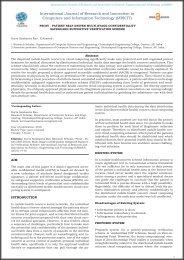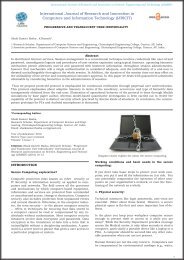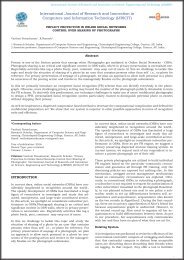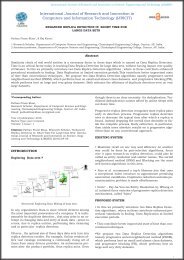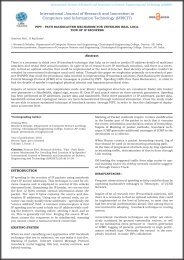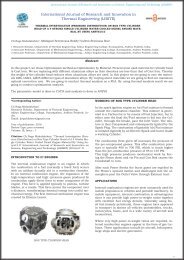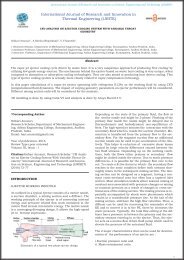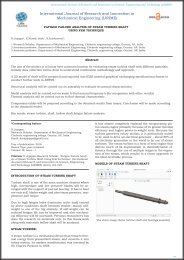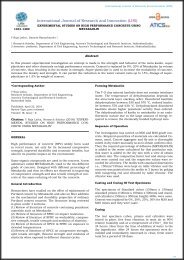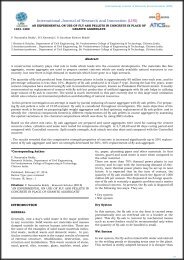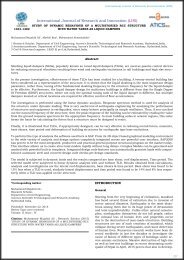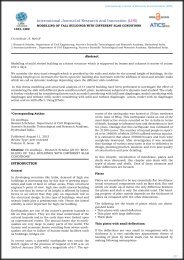MODEL ON CARPOOLING TECHNIQUE TO REDUCE CONGESTION
As is the trend worldwide, India is undergoing rapid urbanization. This means not only that more people than ever before will be living and working in cities, but also that more people and more goods will be making more and longer trips in urban areas. The costs of increasing dependence on cars is resulting in expensive road building and maintenance, clogged and congested roads, high levels of energy consumption along with its economic and environmental costs, worsening air and noise pollution, traffic accidents and social inequities that arise when the poor find transportation services increasingly unaffordable. The most widely used mode of conveyance of public transport in Hyderabad is “buses”. Thus buses form a backbone of the transportation system in Hyderabad and serve about half of the travel demand while it constitutes less than 1 % of the total vehicle fleet of Hyderabad. In spite of this, it does not receive any preferential treatment in terms of traffic management, dedicated lanes, and better upkeep/ maintenance of vehicles resulting in that common man who can afford even slightly is shifting from buses to their own vehicles. It may be two-wheelers or four wheelers or even bicycles because of which the number of vehicles on the roads are increasing which is leading to further lowering of speed, congestion, increase in pollution level etc. Strategies to combat these problems would include reducing the emissions per vehicle kilometer traveled and the total number of kilometers traveled. Road congestion may be reduced by the use of good public transport management, traffic management and car pools etc. In this paper, we have conducted a survey based on a structured questionnaire for carpooling.
As is the trend worldwide, India is undergoing rapid urbanization. This means not only that more people than ever before
will be living and working in cities, but also that more people and more goods will be making more and longer trips
in urban areas. The costs of increasing dependence on cars is resulting in expensive road building and maintenance,
clogged and congested roads, high levels of energy consumption along with its economic and environmental costs, worsening
air and noise pollution, traffic accidents and social inequities that arise when the poor find transportation services
increasingly unaffordable.
The most widely used mode of conveyance of public transport in Hyderabad is “buses”. Thus buses form a backbone
of the transportation system in Hyderabad and serve about half of the travel demand while it constitutes less than 1 %
of the total vehicle fleet of Hyderabad. In spite of this, it does not receive any preferential treatment in terms of traffic
management, dedicated lanes, and better upkeep/ maintenance of vehicles resulting in that common man who can afford
even slightly is shifting from buses to their own vehicles. It may be two-wheelers or four wheelers or even bicycles
because of which the number of vehicles on the roads are increasing which is leading to further lowering of speed, congestion,
increase in pollution level etc. Strategies to combat these problems would include reducing the emissions per
vehicle kilometer traveled and the total number of kilometers traveled. Road congestion may be reduced by the use of
good public transport management, traffic management and car pools etc. In this paper, we have conducted a survey
based on a structured questionnaire for carpooling.
Create successful ePaper yourself
Turn your PDF publications into a flip-book with our unique Google optimized e-Paper software.
International Journal of Research and Innovation (IJRI)<br />
1401-1402<br />
International Journal of Research and Innovation (IJRI)<br />
<strong>MODEL</strong> <strong>ON</strong> <strong>CARPOOLING</strong> <strong>TECHNIQUE</strong> <strong>TO</strong> <strong>REDUCE</strong> C<strong>ON</strong>GESTI<strong>ON</strong><br />
Gaddam Ushadri 1 , Rohith SR Mane 2 , K. Mythili 3<br />
1 Research Scholar, Department of Civil Engineering, Aurora Scientific Technological and Research Academy, Hyderabad India.<br />
2 Assistant Professor, Department of Civil Engineering, Aurora Scientific Technological and Research Academy, Hyderabad India.<br />
3 Associate professor, Department of Civil Engineering, Aurora Scientific Technological and Research Academy, Hyderabad India.<br />
Abstract<br />
As is the trend worldwide, India is undergoing rapid urbanization. This means not only that more people than ever before<br />
will be living and working in cities, but also that more people and more goods will be making more and longer trips<br />
in urban areas. The costs of increasing dependence on cars is resulting in expensive road building and maintenance,<br />
clogged and congested roads, high levels of energy consumption along with its economic and environmental costs, worsening<br />
air and noise pollution, traffic accidents and social inequities that arise when the poor find transportation services<br />
increasingly unaffordable.<br />
The most widely used mode of conveyance of public transport in Hyderabad is “buses”. Thus buses form a backbone<br />
of the transportation system in Hyderabad and serve about half of the travel demand while it constitutes less than 1 %<br />
of the total vehicle fleet of Hyderabad. In spite of this, it does not receive any preferential treatment in terms of traffic<br />
management, dedicated lanes, and better upkeep/ maintenance of vehicles resulting in that common man who can afford<br />
even slightly is shifting from buses to their own vehicles. It may be two-wheelers or four wheelers or even bicycles<br />
because of which the number of vehicles on the roads are increasing which is leading to further lowering of speed, congestion,<br />
increase in pollution level etc. Strategies to combat these problems would include reducing the emissions per<br />
vehicle kilometer traveled and the total number of kilometers traveled. Road congestion may be reduced by the use of<br />
good public transport management, traffic management and car pools etc. In this paper, we have conducted a survey<br />
based on a structured questionnaire for carpooling.<br />
By the analysis of the data collected, we found that if there is no carpooling, the amount required for 968316 Kilolitre<br />
petrol for 1289231 cars is Rs.4213.14crores per annum while by carpooling, this amount reduces to Rs. 4213.14-<br />
1310.98 =2902.16 crores. Thus, a revenue of Rs. 1310.98 crores can be saved by saving 301307 Kilolitre petrol by<br />
carpooling in Hyderabad.<br />
By the analysis of the data collected, we found that if there is no carpooling, the amount required for 968316 Kilolitre<br />
petrol for 1289231 cars is Rs.4213.14crores per annum while by carpooling, this amount reduces to Rs. 4213.14-<br />
1310.98 =2902.16 crores. Thus, a revenue of Rs. 1310.98 crores can be saved by saving 301307 Kilolitre petrol by<br />
carpooling in Hyderabad.<br />
*Corresponding Author:<br />
Gaddam Ushadri,<br />
Research Scholar, Department of Civil Engineering,<br />
Aurora Scientific Technological and Research Academy,<br />
Hyderabad India.<br />
Published: July 11, 2015<br />
Review Type: peer reviewed<br />
Volume: II, Issue : II<br />
Citation: Gaddam Ushadri,Research Scholar (2015)<br />
"<strong>MODEL</strong> <strong>ON</strong> <strong>CARPOOLING</strong> <strong>TECHNIQUE</strong> <strong>TO</strong> <strong>REDUCE</strong> C<strong>ON</strong>GES-<br />
TI<strong>ON</strong>"<br />
INTRODUCTI<strong>ON</strong><br />
Transportation contributes to the economic, industrial,<br />
social and cultural development of any country. It has a<br />
vital role for economic development of any region, nation,<br />
since, development follows the lines of transportation<br />
since the basic media surround human being viz, land,<br />
water and air the modes of transport are connected with<br />
these three media for movements.<br />
The four major systems of transportation are,<br />
Road ways<br />
Railways<br />
Waterways<br />
Airways<br />
Road ways are basically of two types .i.e. (a) Urban Road<br />
ways and (b) Rural road ways Among the above major<br />
modes of transportation, road is die only mode which<br />
could give maximum service to one and all. This mode has<br />
the maximum flexibility for travel with reference to route,<br />
direction, time and speed of travel etc., It is possible to<br />
provide door to door service only by road transport. The<br />
nature of transport system depends upon the economic<br />
status, social development, geographic and topographical<br />
conditions and the choice of modes of individuals.<br />
Fast, cheap and comfortable modes of transport are used<br />
frequently. No one mode of transport combines all these<br />
qualities. The majority of population who are economically<br />
backward will give prime importance to the least expensive<br />
transport system.<br />
Nature of Indian traffic<br />
Road traffic has been growing at a very rapid rate in India.<br />
131
International Journal of Research and Innovation (IJRI)<br />
The number of motor Vehicles is also growing at a rapid<br />
rate. The investments on roads have not kept pace with<br />
the growth of traffic, leading to many problems like severe<br />
congestion, low speeds, high operation costs etc.,<br />
One of the major problems associated with Indian traffic<br />
is its heterogeneous nature In general, traffic streams are<br />
not uniform, but vary over both space and time The traffic<br />
on Indian roads, termed as mixed traffic consists of variety<br />
of modes, starting from human powered, bicycle to motorized<br />
multi- axle heavy commercial vehicles. These modes<br />
exhibit different physical and operational characteristics<br />
and the variety of situations that can result because of<br />
the interaction of these modes under the traffic stream<br />
analysis more complex. At this juncture it would be appropriate<br />
to understand the effect of individual mode on<br />
traffic speeds because speed is the crucial factor in urban<br />
traffic. In this study motorized two wheelers is taken as<br />
the mode whose effect is evaluated on traffic speeds.<br />
Methodology<br />
The intent of this chapter is to explain the procedure<br />
which is adopted in this present study. A flow chart<br />
involving proposed methodology is shown in fig 3.1 and<br />
explains each step briefly<br />
Hyderabad traffic scenario<br />
In Hyderabad, public transport such as buses, auto rickshaws<br />
and multi modal railways are the most frequently<br />
used transport by the residents. The composition of vehicles<br />
m Hyderabad are , 75% two-wheelers, 14% cars,<br />
1% taxis, 4% goods vehicles, 2% buses (including 3,800<br />
RTC buses) and 4% other vehicles (including 71,000 auto<br />
rickshaws). In some parts of the city cycle rickshaws are<br />
used as a means of public transport for smaller distances.<br />
Hyderabad is sixth largest metropolitan city in India covering<br />
an area approximately 1554 sqkm. The city not only<br />
became an industrial centre but also a major centre for<br />
trade, commerce and culture.<br />
Growth of Vehicles in Telengana has been recording<br />
a sustained growth in the number of vehicles over the<br />
years. The development of good infrastructure, besides<br />
the state emerging as a major IT hub has enabled the accelerated<br />
growth of vehicles<br />
Sl. No<br />
CLASS OF VEHI- Nos.<br />
CLE<br />
1. Auto Rickshaws 576453<br />
2 Contract Carriages 6530<br />
3 Educational institution<br />
29804<br />
Buses<br />
4. Goods Carriages 550699<br />
5 Maxi Cabs 32178<br />
6 Mopeds and Motor 8608056<br />
Cycles<br />
7. Motor Cars 1083942<br />
8 Motor Cabs 98939<br />
9 Private Service 5497<br />
Vehicles<br />
10 Stage Carnages 31608<br />
11. Tractor and Trailers<br />
660763<br />
12. Others 72279<br />
Total 11756748<br />
Hyderabad is a historical city as 400 years of history. It is<br />
gone through complex evolutionary process of social, economical,<br />
political change over these years. It was and it<br />
will be center of migration with in state and country since<br />
it is having large number of employment opportunities.<br />
Methodology adopted for the study<br />
Study includes review of literature on traffic volume,<br />
speed and density with and with out car pooling and<br />
bike pooling by green shield analysis. Preliminary surveys<br />
were performed for identification of suitable study<br />
stretches<br />
DATA COLLECTI<strong>ON</strong><br />
General<br />
Data collection forms the very basis of any research activity<br />
and type of data to be collected is largely dependent<br />
on the objectives of the study.The items of interest in<br />
traffic theory have been the following<br />
•Rates of flow (vehicles per unit time)<br />
•Speeds (distance per unit time)<br />
•Travel time over a known length of road<br />
•Occupancy (percent of time a point on the road is occupied<br />
by vehicles);<br />
•Density (vehicles per unit distance)<br />
•Time headway between vehicles (time per vehicle)<br />
•Spacing, or space headway between vehicles (distance<br />
per vehicle) and concentration (measured by density or<br />
occupancy)<br />
Measurement capabilities for obtaining traffic data have<br />
changed over the nearly 60- year span of interest in traffic<br />
flow, and more so in the past 40 years during which there<br />
have been a large number of freeways Indeed, measurement<br />
capabilities are still changing.<br />
In this dissertation the survey for the data collection was<br />
designed so as to fit in the framework of the objective In<br />
the traffic studies, apart from the traffic parameters such<br />
as density, flow and speed, the geometries of the locations<br />
have enormous influence on the traffic behavior Hence<br />
132
International Journal of Research and Innovation (IJRI)<br />
the selection of location for the collection of data assumes<br />
much significance in the traffic stream studies Five mid<br />
blocks were selected for traffic volume and spot speed<br />
studies. The details of locations selected for the present<br />
study and the methodology adopted and the data collected<br />
are presented in the following articles.<br />
ANALYSIS OF DATA<br />
General<br />
To design new traffic facilities and new control plans for<br />
the existing facilities, it is necessary to predict the performance<br />
of traffic to the traffic engineer with regard to<br />
variety of characteristics to improve the existing and design<br />
the new one. It should be feasible for traffic engineer<br />
to make this prediction with limited amount of data<br />
available. In traffic engineering, statistical methods are<br />
a powerful tool to analyze and interpret the data among<br />
such statistical methods. Greenshield analysis is very extensively<br />
used and powerful method depending upon the<br />
type of situation of being studied, analysis can range from<br />
the simple and straight forward to the complex.<br />
Pooling Technique<br />
By standardising the number of cars i.e to ride comfortably<br />
in a car normally four passengers can be seated.<br />
So dividing the total number of cars by four, for the same<br />
number of passengers optimum number of cars on road<br />
can be obtained.<br />
By standardising the number of bikes i.e to ride comfortably<br />
on bike normally two passengers can be seated. So<br />
dividing the total number of bikes by two, for the same<br />
number of passengers optimum number of motorised two<br />
wheelers on road can be obtained.<br />
Traffic flow at ameerpet – S.R Nagar Midblock with<br />
pooling system<br />
Hour<br />
of<br />
count<br />
8-9<br />
am<br />
9-10<br />
am<br />
10-11<br />
am<br />
11-12<br />
am<br />
Buses Trucks Cars Two<br />
Wheelers<br />
Three<br />
Wheelers<br />
Total<br />
Vol/<br />
Hr<br />
49 10 33 255 26 1 375<br />
52 11 60 330 28 4 485<br />
53 13 115 493 26 3 703<br />
55 14 167 53 31 3 323<br />
12-1pm 47 11 62 47 27 5 623<br />
1-2<br />
pm<br />
32 12 32 201 18 3 298<br />
2-3 pm 42 13 88 180 18 4 345<br />
3-4 pm 46 17 69 181 12 4 329<br />
4-5 pm 52 10 94 283 20 3 462<br />
5-6 pm 67 8 122 400 44 4 646<br />
6-7 pm 77 16 119 598 24 4 838<br />
7-8 pm 64 11 135 562 20 3 795<br />
8-9 pm 56 9 142 501 19 2 729<br />
After applying the pooling technique as mentioned in<br />
5.3.1 the maximum number of vehicles changed from<br />
1794 to 838 vehicles per hour.<br />
Traffic flow at Nagole – LB Nagar Midblock with<br />
Pooling system<br />
Hour<br />
of<br />
count<br />
Buses Trucks Cars Two<br />
Wheelers<br />
Three<br />
Wheelers<br />
Total<br />
Vol/<br />
Hr<br />
8-9am 32 8 62 235 12 1 773<br />
9-10am 49 9 81 350 17 1 507<br />
Bicycles<br />
Bicycles<br />
10-<br />
11am<br />
11-12<br />
am<br />
52 06 123 848 18 3 1050<br />
53 11 116 566 16 4 766<br />
12-1pm 55 10 110 420 22 1 618<br />
1-2pm 46 12 89 225 16 2 390<br />
2-3 pm 33 10 60 205 8 1 317<br />
3-4 pm 42 11 1163 215 14 3 348<br />
4-5 pm 47 13 60 232 9 1 362<br />
5-6 pm 42 10 86 283 24 2 447<br />
6-7 pm 74 13 108 526 34 1 756<br />
7-8 pm 62 08 136 551 20 2 779<br />
8-9 pm 52 11 152 573 15 1 807<br />
After applying the pooling technique as mentioned in 5.3<br />
the maximum number of vehicles changed from 1836 to<br />
1050 vehicles per hour.<br />
Traffic flow at Ramanthapur – Amberpet Midblock<br />
with pooling system<br />
Hour<br />
of<br />
count<br />
8-9<br />
am<br />
9-10<br />
am<br />
Bicycles<br />
10-<br />
11am<br />
11-12<br />
am<br />
Buses Trucks Cars Two<br />
Wheelers<br />
Three<br />
Wheelers<br />
Total<br />
Vol/<br />
Hr<br />
31 6 24 295 17 1 374<br />
36 10 165 291 17 1 520<br />
44 11 99 300 37 3 494<br />
51 6 88 310 18 1 474<br />
12-1pm 37 12 79 251 28 2 409<br />
1-2pm 28 11 80 252 18 1 390<br />
2-3 pm 22 8 81 168 20 2 301<br />
3-4 pm 35 9 73 183 20 2 322<br />
4-5 pm 31 10 44 137 42 1 265<br />
5-6 pm 36 9 64 178 24 1 312<br />
6-7 pm 39 6 36 175 23 1 330<br />
7-8 pm 35 7 120 220 37 2 421<br />
8-9 pm 33 9 101 343 31 1 518<br />
After applying the pooling technique as mentioned in 5.3<br />
the maximum number of vehicles changed from 1305 to<br />
518 vehicles per hour.<br />
Traffic flow at Dilsuknagar– Chaitanyapuri Midblock<br />
with pooling system<br />
Hour<br />
of<br />
count<br />
Buses Trucks Cars Two<br />
Wheelers<br />
Three<br />
Wheelers<br />
8-9am 34 3 85 235 19 1<br />
9-10am 41 5 86 245 21 1<br />
Bicycles<br />
10-<br />
11am<br />
11-12<br />
am<br />
47 7 125 360 20 2<br />
52 11 118 638 20 4<br />
Total<br />
Vol/<br />
Hr<br />
12-1pm 54 9 113 706 24 1 907<br />
377<br />
399<br />
561<br />
843<br />
133
International Journal of Research and Innovation (IJRI)<br />
1-2pm 45 11 89 425 20 1<br />
2-3 pm 32 21 63 225 12 0<br />
3-4 pm 42 11 88 210 20 0<br />
4-5 pm 47 16 60 220 15 0<br />
5-6 pm 42 26 86 237 24 2<br />
6-7 pm 70 17 106 293 32 0<br />
7-8 pm 60 09 144 401 21 0<br />
8-9 pm 61 14 149 506 18 0<br />
After applying the pooling technique as mentioned in 5.3<br />
the maximum number of vehicles changed from 1954 to<br />
907 vehicles per hour.<br />
Traffic flow at JNTU– Miyapur Midblock with pooling<br />
system<br />
Hour<br />
of<br />
count<br />
Buses Trucks Cars Two<br />
Wheelers<br />
Three<br />
Wheelers<br />
8-9am 33 2 21 235 12 0<br />
9-10am 64 5 81 405 16 0<br />
Bicycles<br />
10-<br />
11am<br />
11-12a<br />
m<br />
87 7 120 558 18 1<br />
86 12 113 616 16 2<br />
12-1pm 64 9 431 475 21 0<br />
1-2pm 49 13 89 435 17 0<br />
2-3 pm 37 21 60 255 8 0<br />
3-4 pm 44 17 63 270 14 1<br />
4-5 pm 41 18 59 237 9 0<br />
5-6 pm 36 26 88 393 23 2<br />
6-7 pm 39 18 108 736 34 0<br />
7-8 pm 61 08 136 856 20 2<br />
8-9 pm 69 22 152 587 17 1<br />
591<br />
353<br />
371<br />
358<br />
417<br />
518<br />
635<br />
748<br />
Total<br />
Vol/<br />
Hr<br />
303<br />
571<br />
791<br />
845<br />
667<br />
603<br />
381<br />
409<br />
364<br />
566<br />
935<br />
1081<br />
After applying the pooling technique as mentioned in 5.3<br />
the maximum number of vehicles changed from 2350 to<br />
1081 vehicles per hour.<br />
The above data is analysed by using greenshield model as<br />
mentioned in 3.6.1 and 3.7.1 of calibration of greenshield<br />
model.<br />
Ammerpet- Sr Nagar With Out Pooling technique<br />
Density (x)<br />
Speed (y)<br />
29 25<br />
37 27<br />
67 23<br />
29 30<br />
51 25<br />
17 35<br />
25 32<br />
847<br />
23 31<br />
36 29<br />
52 27<br />
81 22<br />
80 22<br />
61 23<br />
588 351<br />
Amerpet- Sr Nagar mid block With Pooling technique<br />
Density<br />
Speed<br />
15 25<br />
18 27<br />
30 23<br />
11 30<br />
25 25<br />
8 35<br />
11 32<br />
11 31<br />
16 29<br />
24 27<br />
38 22<br />
36 22<br />
37 23<br />
588 351<br />
Ameerpet – Sr Nagar Mid Block<br />
Without Pooling<br />
Maximum Density = 430 Veh/Km<br />
Maximum Flow = 3246 Veh/Hr<br />
With Pooling<br />
Maximum Density = 260 Veh/Km<br />
Maximum Density = 2018 Veh/Km<br />
Nagole - LB Nagar With Out Pooling technique<br />
Density<br />
Speed<br />
15 25<br />
18 27<br />
30 23<br />
11 30<br />
25 25<br />
8 35<br />
11 32<br />
11 31<br />
16 29<br />
24 27<br />
38 22<br />
36 22<br />
37 23<br />
134
International Journal of Research and Innovation (IJRI)<br />
By Analyzing this as the above, using green shield equation<br />
Jam Density = 306Veh/Km<br />
Maximum Flow = 2341Veh/hr<br />
Nagole - LB Nagar With Pooling technique<br />
Density<br />
Speed<br />
15 25<br />
18 27<br />
30 23<br />
11 30<br />
25 25<br />
8 35<br />
11 32<br />
11 31<br />
16 29<br />
24 27<br />
38 22<br />
36 22<br />
37 23<br />
By Analyzing this as the above, using green shield equation<br />
Jam Density = 222Veh/Km<br />
Maximum Flow = 1738Veh/hr<br />
Ramnthapur- Amberpet With out Pooling technique<br />
Density<br />
Speed<br />
15 25<br />
18 27<br />
30 23<br />
11 30<br />
25 25<br />
8 35<br />
11 32<br />
11 31<br />
16 29<br />
24 27<br />
38 22<br />
36 22<br />
37 23<br />
By Analyzing this as the above, using green shield equation<br />
Jam Density = 379Veh/Km<br />
Maximum Flow = 2871Veh/hr<br />
Ramnthapur- Amberpet with pooling technique<br />
Density<br />
15 25<br />
18 27<br />
30 23<br />
11 30<br />
25 25<br />
8 35<br />
11 32<br />
11 31<br />
Speed<br />
16 29<br />
24 27<br />
38 22<br />
36 22<br />
37 23<br />
By Analyzing this as the above, using green shield equation<br />
Jam Density = 307Veh/Km<br />
Maximum Flow = 2370Veh/hr<br />
DilsukhNagar - Chaitanyapuri With out Pooling<br />
technique<br />
Density<br />
Speed<br />
15 25<br />
18 27<br />
30 23<br />
11 30<br />
25 25<br />
8 35<br />
11 32<br />
11 31<br />
16 29<br />
24 27<br />
38 22<br />
36 22<br />
37 23<br />
By Analyzing this as the above, using green shield equation<br />
Jam Density = 387Veh/Km<br />
Maximum Flow = 3377Veh/hr<br />
DilsukhNagar -Chaitanyapuri With Pooling technique<br />
Density<br />
15 25<br />
18 27<br />
30 23<br />
11 30<br />
25 25<br />
8 35<br />
11 32<br />
11 31<br />
16 29<br />
24 27<br />
38 22<br />
36 22<br />
37 23<br />
Speed<br />
By Analyzing this as the above, using green shield equation<br />
Jam Density = 300Veh/Km<br />
Maximum Flow = 1938Veh/hr<br />
135
International Journal of Research and Innovation (IJRI)<br />
JNTU - Miyapur With out Pooling technique<br />
Density<br />
15 25<br />
18 27<br />
30 23<br />
11 30<br />
25 25<br />
8 35<br />
11 32<br />
11 31<br />
16 29<br />
24 27<br />
38 22<br />
36 22<br />
37 23<br />
Speed<br />
By Analyzing this as the above, using green shield equation<br />
Jam Density = 440Veh/Km<br />
Maximum Flow = 3383Veh/hr<br />
JNTU - Miyapur With Pooling technique<br />
Density<br />
Speed<br />
15 25<br />
18 27<br />
30 23<br />
11 30<br />
25 25<br />
8 35<br />
11 32<br />
11 31<br />
16 29<br />
24 27<br />
38 22<br />
36 22<br />
37 23<br />
By Analyzing this as the above, using green shield equation<br />
Jam Density = 218Veh/Km<br />
Maximum Flow = 1669 Veh/hr<br />
SUMMARY AND C<strong>ON</strong>CLUSI<strong>ON</strong>S<br />
Summary<br />
The present study is mainly intended for effect of pooling<br />
system on traffic volume and traffic density on five mid<br />
blocks. As the number of motorized two wheelers and cars<br />
causing problems related to traffic in Hyderabad. There is<br />
a need to assess their effect on traffic . In this study five<br />
mid blocks are selected in which arc having more than<br />
50% of two wheelers and 25% of cars.<br />
The selected mid blocks were<br />
Ameerpet - S R.Nagar<br />
Ramanthapur – Amberpet<br />
Nagole - L.B. Nagar<br />
DilsukhNagar-Chaitanyapur<br />
Jntu-Miyapur<br />
These mid blocks have different speeds and volumes. It<br />
is observed that after applying pooling technique there<br />
is a reduction in maximum flow and jam density.Graphs<br />
are drawn between traffic density and traffic speed. From<br />
these graphs, by using greenshield analysis it is observed<br />
that there is a reduction in density and flow values.<br />
Conclusions<br />
The following conclusions can be drawn based on the present<br />
data<br />
• From the study it is revealed that there is definite influence<br />
of pooling technique on traffic flow and density.<br />
• In ammerpet- sr nagar midblock before and after pooling<br />
the maximum flow varies from 3246 veh/hr to 2018<br />
veh/hr and jam density varies from 430 veh/km to 260<br />
veh/km.<br />
• In Ramanthpur-amberpet midblock before and after<br />
pooling the maximum flow varies from 2871 veh/hr to<br />
2370 veh/hr and jam density varies from 379 veh/km to<br />
307 veh/km<br />
• In Nagole-Lb nagar midblock before and after pooling<br />
the maximum flow varies from 2341 Veh/hr to 1738 veh/<br />
hr and jam density varies from 306 veh/km to 222veh/<br />
km.<br />
• In Dilsukhnagar-chaitanyapuri midblock before and after<br />
pooling the maximum flow varies from 3377 veh/hr to<br />
1938 veh/hr and jam density varies from 387 veh/km to<br />
300 veh/km.<br />
• In Jntu-Miyapur midblock before and after pooling the<br />
maximum flow varies from 3383 veh/hr to 1669 veh/hr<br />
and jamm density varies from 440 veh/km to 218 veh/<br />
km.<br />
Limitations<br />
Assessment of influence of individual mode on mixed traffic<br />
is a complex phenomenon. Instead the mode itself is<br />
influenced by the behavior of other modes i.e. violating<br />
the traffic rules etc. So if an authoritative and meaningful<br />
relationship is to be developed. A thorough investigation<br />
into all the factors and modes that are influencing the<br />
motorized two wheelers behavior is too carried out. This<br />
is possible only when a comprehensive study is made resulting<br />
in extensive data base. The selected study area is<br />
independent of pavement conditions, climatic conditions,<br />
number of lanes, type of shoulders etc.<br />
The present study is a time bound project and and as traffic<br />
is homogeneous, lack of adequate database in mixed<br />
traffic conditions has been a major constraint during the<br />
assessment of effect of pooling on traffic flow and traffic<br />
density. However considering this as a beginning step in a<br />
new direction, this study has been carried out.<br />
REFERENCES<br />
1. Kadiyali, L R.(!981), Free Speeds of vehicles on Indian roads.<br />
Paper No 343 journal of Indian Road Congress, vol. 42-3. New<br />
Delhi Kadiyali, Speed-Flow characteristics on Indian Highways,<br />
vol 52-2, Indian Road Congress. New Delhi.<br />
2. Adams, W.P., Road traffic considered as a random series, journal<br />
of the institution of civil engineers, London.<br />
3. Lowell wing, R., (1996) Statistics for scientists and engineers,<br />
Prentice Hall of India Private limited., New Delhi.<br />
4 . Chatteijee S. and B Price. (1977) Regression Analysis by example.<br />
John Wiley and sons New York.<br />
5 . Roads Wing, Ministry of shipping and transport, Government<br />
of India, Report of the Technical Group set up by the Government<br />
of India.<br />
6. United nations Manual on Traffic Surveys, New Delhi.<br />
7. Indian Road congress, Traffic Census on Urban Roads<br />
IRC.1972, New Delhi.<br />
136
International Journal of Research and Innovation (IJRI)<br />
8. Traffic Counting Classification and weighing, U.S. Bureau of<br />
Public Roads.<br />
9.Measuring Traffic volumes, National Committee on Urban<br />
Transportation, U.S.A.<br />
10. Kadiyali, L.R., (1981) Average occupancy of Indian cars,<br />
RUCS Technical Paper No.65 Thirteen quarterly report, Central<br />
Road Research Institute, New Delhi.<br />
11. Motor Transport Statistics, Ministry of Surface Transport,<br />
Transport Research Division, New Delhi.<br />
12. Society of Indian Automobile Manufacturer<br />
13. Traffic in towns, The Buchanan Report, H.M.S.O., London.<br />
14. Roads in Urban Areas. Ministry of transport, H.M.S.O., London.<br />
15. L.R. Kadiyali, (1973) A Study of the problems of single lane<br />
Pavements in India and their improvements, Paper No. 296,<br />
Journal of the I R C,New Delhi.<br />
16. Arasan, V.T., and Kashani., S.H. (2003). “Modeling Platoon<br />
Dispersal Pattern of heterogeneous Road Traffic" Proceedings of<br />
the 82nd Annual Meeting of transportation Research Board.<br />
17. Chandra, S., and Sikdar, P, K. (2000). “Factors affecting PCU<br />
in mixed traffic situation on Urban roads”.<br />
18. Chandra, S., and Kumar, U.(2003). “Effect of Lane Width<br />
on Capacity under Mixed traffic Conditions in India”. Journal of<br />
Transportation Engineering, Vol. 129, ASCIi,155-160.<br />
19. Cunagin, W.D., and Messer, C.J. (1983). (Passenger-car<br />
equivalents for rural highways). transportation Research Record<br />
905, Transportation Research Board,Washington, D.C. 61-68.<br />
20. Elefteriadou, L., Torbic, D., and Webster, N. (1997). “Development<br />
of passenger car equivalents for freeways, two-lane<br />
highways, and arterials”.transportation Research Record 1572,<br />
Transportation Research Board, Washington, D.C., 51-58.<br />
21. Huber, MJ. (1982). “Estimation of passenger-car equivalents<br />
of trucks in trafficstream”.Transportation Research Record 869,<br />
Transportation Research Board, Washington, D.C., 60- 68.<br />
22. IRC: 86-1983, Geometric Design Standards for Urban Roads<br />
in Plains, Indian Roads Congress, New Delhi.<br />
23. IRC: 106-1990, Guidelines for Capacity of Urban Roads in<br />
Plain Areas, Indian Road Congress, New Delhi.<br />
24. Kumar, V.M., and Rao, S.K. (1996). “Simulation modelling<br />
of traffic operations on two-lane highways”. Highway Research<br />
Bulletin, No. 54, Indian Roads Congress,Highway Research<br />
Board, 211 - 237.<br />
25. Maitra, B., Sikdar, P.K., and Dhingra, S.L. (1999). “Modelling<br />
Congestion on UrbanRoads and Assessing Level of Service”.<br />
Journal of Transportation Engineering,ASCE, Vol. 125,No.6,08-<br />
514.<br />
26. Rajagopal, A. and Dhingra, S. L. (2002). “Simulation-based<br />
evaluation for traffic management”. National Conference on<br />
Transportation Systems (NCTS), 1IT New Delhi.<br />
27. Ramanayya, T.V. (1988). “Highway capacity under mixed<br />
traffic conditions” Traffic Engineering and Control, Vol. 29 (5),<br />
28. Sacks, J., Rouphnil. N.M.. Park. B and Thakurtah, P (2002).<br />
"Staticaily-Based validation Of Computer Simulation Models in<br />
Traffic Operations and Management Journal of transportation<br />
Statistics”<br />
29.Law, A.M., and Kclton, W.D. (2000). Simulation modeling and<br />
analysis. McGraw- Hill Higher Education, Singapore.Oppenlander,<br />
J.C. Sample Size Determination forSpot-Specd Studies at<br />
Rural, Intermediate, and Urban Locations. In Highway Research<br />
Record: Journal of the Highway Research Board. No. 35.<br />
Author<br />
Gaddam Ushadri<br />
Research Scholar,<br />
Department of Civil Engineering,<br />
Aurora Scientific Technological and Research Academy,<br />
Hyderabad India.<br />
Rohith SR Mane<br />
Assistant Professor,<br />
Department of Civil Engineering,<br />
Aurora Scientific Technological and Research Academy,<br />
Hyderabad India.<br />
K. Mythili<br />
Associate professor,<br />
Department of Civil Engineering,<br />
Aurora Scientific Technological and Research Academy,<br />
Hyderabad India.<br />
137




